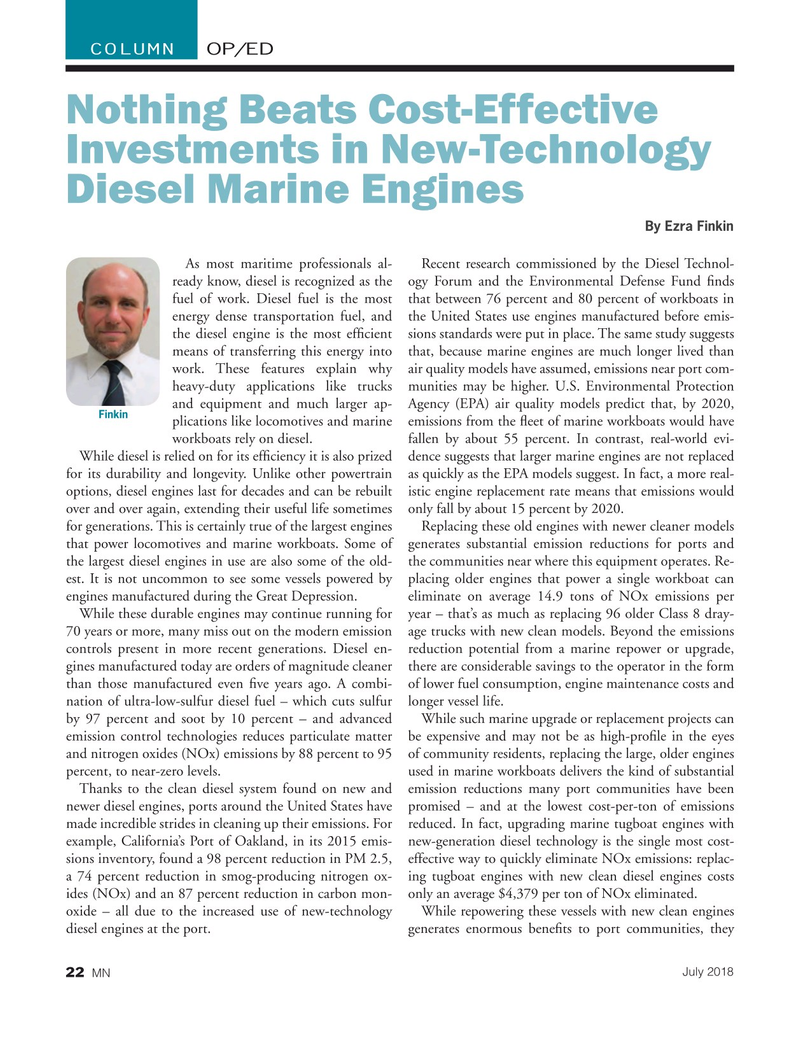
Page 22: of Marine News Magazine (July 2018)
Propulsion Technology
Read this page in Pdf, Flash or Html5 edition of July 2018 Marine News Magazine
COLUMN OP/ED
Nothing Beats Cost-Effective
Investments in New-Technology
Diesel Marine Engines
By Ezra Finkin
As most maritime professionals al- Recent research commissioned by the Diesel Technol- ready know, diesel is recognized as the ogy Forum and the Environmental Defense Fund ? nds fuel of work. Diesel fuel is the most that between 76 percent and 80 percent of workboats in energy dense transportation fuel, and the United States use engines manufactured before emis- the diesel engine is the most ef? cient sions standards were put in place. The same study suggests means of transferring this energy into that, because marine engines are much longer lived than work. These features explain why air quality models have assumed, emissions near port com- heavy-duty applications like trucks munities may be higher. U.S. Environmental Protection and equipment and much larger ap- Agency (EPA) air quality models predict that, by 2020,
Finkin plications like locomotives and marine emissions from the ? eet of marine workboats would have workboats rely on diesel. fallen by about 55 percent. In contrast, real-world evi-
While diesel is relied on for its ef? ciency it is also prized dence suggests that larger marine engines are not replaced for its durability and longevity. Unlike other powertrain as quickly as the EPA models suggest. In fact, a more real- options, diesel engines last for decades and can be rebuilt istic engine replacement rate means that emissions would over and over again, extending their useful life sometimes only fall by about 15 percent by 2020.
for generations. This is certainly true of the largest engines Replacing these old engines with newer cleaner models that power locomotives and marine workboats. Some of generates substantial emission reductions for ports and the largest diesel engines in use are also some of the old- the communities near where this equipment operates. Re- est. It is not uncommon to see some vessels powered by placing older engines that power a single workboat can engines manufactured during the Great Depression. eliminate on average 14.9 tons of NOx emissions per
While these durable engines may continue running for year – that’s as much as replacing 96 older Class 8 dray- 70 years or more, many miss out on the modern emission age trucks with new clean models. Beyond the emissions controls present in more recent generations. Diesel en- reduction potential from a marine repower or upgrade, gines manufactured today are orders of magnitude cleaner there are considerable savings to the operator in the form than those manufactured even ? ve years ago. A combi- of lower fuel consumption, engine maintenance costs and nation of ultra-low-sulfur diesel fuel – which cuts sulfur longer vessel life. by 97 percent and soot by 10 percent – and advanced While such marine upgrade or replacement projects can emission control technologies reduces particulate matter be expensive and may not be as high-pro? le in the eyes and nitrogen oxides (NOx) emissions by 88 percent to 95 of community residents, replacing the large, older engines percent, to near-zero levels. used in marine workboats delivers the kind of substantial
Thanks to the clean diesel system found on new and emission reductions many port communities have been newer diesel engines, ports around the United States have promised – and at the lowest cost-per-ton of emissions made incredible strides in cleaning up their emissions. For reduced. In fact, upgrading marine tugboat engines with example, California’s Port of Oakland, in its 2015 emis- new-generation diesel technology is the single most cost- sions inventory, found a 98 percent reduction in PM 2.5, effective way to quickly eliminate NOx emissions: replac- a 74 percent reduction in smog-producing nitrogen ox- ing tugboat engines with new clean diesel engines costs ides (NOx) and an 87 percent reduction in carbon mon- only an average $4,379 per ton of NOx eliminated.
oxide – all due to the increased use of new-technology While repowering these vessels with new clean engines diesel engines at the port. generates enormous bene? ts to port communities, they
July 2018 22 MN
MN July18 Layout 18-31.indd 22 MN July18 Layout 18-31.indd 22 6/19/2018 4:13:49 PM6/19/2018 4:13:49 PM

 21
21

 23
23
